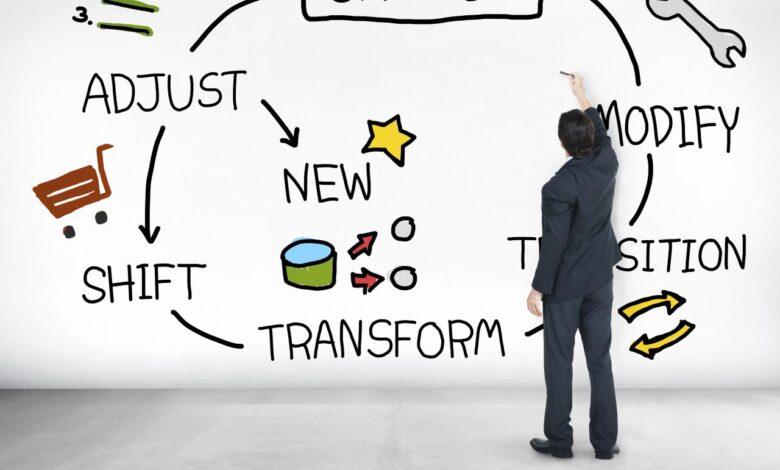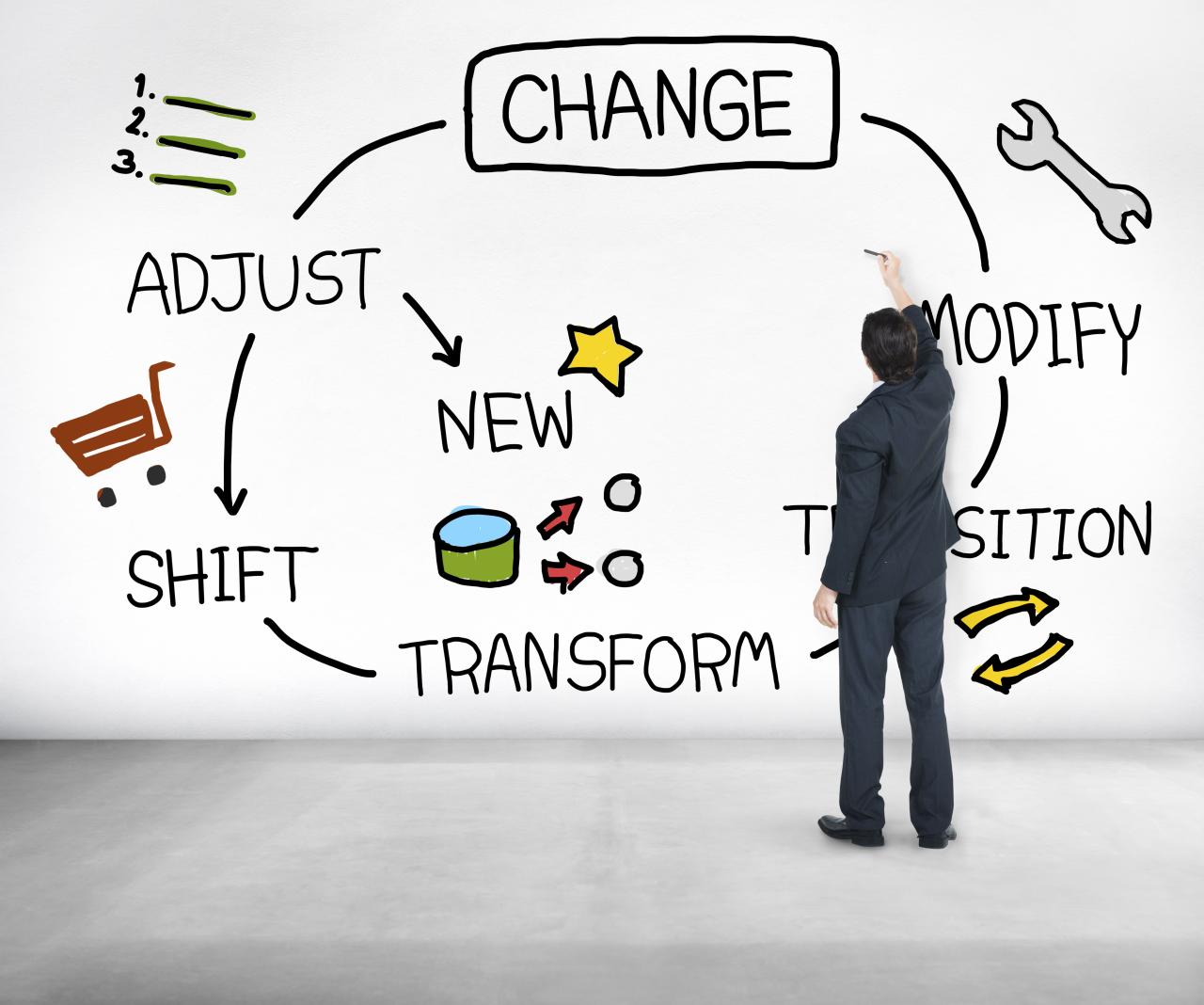
Evolving to Meet Changing Industry Needs
Evolving to meet the needs of a changing industry is crucial for survival and growth in today’s dynamic business environment. This blog post explores the multifaceted strategies necessary for businesses to adapt to evolving market demands, technological advancements, and shifting consumer preferences. From understanding industry shifts to restructuring work processes, we’ll delve into practical approaches for navigating this transformative period.
The retail industry, for example, faces intense pressure from online competition and changing consumer expectations. This requires retailers to not only embrace e-commerce but also to personalize the in-store experience and offer a seamless omnichannel strategy. This necessitates a deep understanding of customer behavior, technological integration, and workforce development to meet the demands of the new landscape.
Understanding Industry Shifts

The modern business landscape is characterized by constant evolution. Industries are reshaped by technological advancements, shifting consumer preferences, and economic fluctuations. This dynamic environment necessitates a proactive approach to understanding and adapting to change. Successfully navigating these shifts hinges on recognizing the drivers of change, the implications of inaction, and the importance of adaptability. Retail, for example, is undergoing a radical transformation, with e-commerce and omnichannel strategies becoming paramount.The retail industry is experiencing a seismic shift driven by a confluence of factors.
Technological advancements, like AI-powered recommendations and personalized shopping experiences, are changing customer expectations. E-commerce platforms have fundamentally altered the way consumers shop, demanding a seamless transition from online browsing to in-store experiences. Changing consumer preferences, prioritizing sustainability and ethical sourcing, are forcing retailers to reassess their supply chains and business models.
Evolving Landscape of Retail
Retail is no longer solely about brick-and-mortar stores. The digital realm has become an integral part of the customer journey, demanding a multi-faceted approach. Omnichannel strategies, combining online and offline experiences, are becoming crucial for success. Retailers are increasingly investing in technologies that personalize customer interactions and anticipate their needs.
Key Drivers of Change
Technological advancements, particularly in areas like artificial intelligence and big data analytics, are fundamentally reshaping retail operations. AI-powered tools are optimizing inventory management, improving customer service, and enhancing marketing campaigns. Changing consumer preferences towards sustainable practices and ethical sourcing are compelling retailers to re-evaluate their supply chains and adopt environmentally friendly strategies. Economic fluctuations, including inflation and recessionary pressures, influence consumer spending patterns and require retailers to adapt pricing strategies and optimize operational costs.
Adaptability in Retail
Adaptability is paramount in navigating the evolving retail landscape. Retailers must embrace innovation, exploring new technologies and strategies to stay competitive. A flexible approach to inventory management, supply chains, and pricing is essential to handle market fluctuations. The ability to quickly respond to changing consumer preferences is crucial for retaining customer loyalty and driving sales.
Consequences of Failing to Adapt
Retailers who fail to adapt to these changes risk becoming obsolete. A lack of investment in e-commerce and omnichannel strategies can lead to a decline in market share and customer base. Inability to respond to evolving consumer preferences can result in decreased sales and brand loyalty.
Facets of Retail Transformation
| Current Trends | Future Projections | Necessary Adaptations |
|---|---|---|
| Physical stores are still important, but online sales are growing. | Omnichannel strategies will become even more important. Customers expect a seamless experience across all platforms. | Investing in e-commerce infrastructure and optimizing the online shopping experience. |
| Traditional marketing methods are being supplemented by digital marketing. | Personalized marketing will be essential to engage customers effectively. | Developing data-driven marketing strategies that target specific customer segments. |
| Supply chains are facing increasing complexity. | Sustainability and ethical sourcing will become critical factors in consumer choice. | Implementing sustainable practices throughout the supply chain and collaborating with ethical suppliers. |
Adapting Business Strategies
Staying relevant in a dynamic industry requires proactive adaptation of business models. Companies must recognize evolving customer needs, technological advancements, and shifting market trends to maintain competitiveness. This necessitates a flexible approach to strategy, encompassing a thorough understanding of existing models and the courage to embrace innovative approaches.A successful adaptation strategy requires more than just reactive changes. It involves a proactive assessment of current market conditions, anticipating future trends, and developing adaptable strategies to capitalize on emerging opportunities.
This proactive approach allows companies to not just survive, but thrive in the face of industry evolution.
Adapting to a shifting business landscape is crucial, and that includes considering environmental impacts. Organizations need to evolve their practices to meet the needs of a changing industry, and this often involves supporting initiatives like sustaining our waters the fox wolf watershed alliance. This crucial work helps protect our water resources, demonstrating a forward-thinking approach to business in the modern era, ultimately making companies more sustainable and resilient in the long run.
Strategies for Adapting Business Models
Adapting business models involves a comprehensive approach that considers various factors. It’s crucial to assess the strengths and weaknesses of the existing model, evaluate the current market landscape, and identify potential opportunities. This involves analyzing customer preferences, competitor actions, and technological advancements. Only then can effective strategies be formulated to align the business with the changing industry needs.
Examples of Successful Adaptation
Several companies have demonstrated successful adaptation strategies in response to evolving industry needs. Netflix, for example, transitioned from a DVD rental service to a streaming giant, capitalizing on the rise of internet technology and changing consumer preferences. Similarly, Amazon, initially an online bookstore, has expanded its offerings to encompass e-commerce, cloud computing, and digital entertainment, demonstrating adaptability and a willingness to embrace new markets.
These examples highlight the importance of recognizing emerging opportunities and proactively adjusting strategies to seize them.
Identifying New Market Opportunities
Identifying new market opportunities requires a keen understanding of the evolving industry landscape. Market research, competitor analysis, and technological advancements should be monitored to recognize trends that indicate potential growth areas. Analyzing customer feedback and understanding their changing needs is also crucial for identifying new market segments. By combining these insights, businesses can develop tailored strategies to tap into these opportunities and gain a competitive edge.
Comparison of Business Model Transformation Approaches
Different approaches to business model transformation exist. Some companies adopt a phased approach, gradually transitioning their models over time. Others opt for a more radical overhaul, implementing significant changes in a short period. The most effective approach often depends on the specific industry, company resources, and the scale of the transformation required. Factors like financial stability, market responsiveness, and employee engagement need to be carefully considered when selecting a transformation strategy.
Business Model Adaptation Table
| Existing Model | Proposed Changes | Anticipated Benefits |
|---|---|---|
| Traditional brick-and-mortar retail | Integration of e-commerce platform, personalized online experiences, and omnichannel strategies. | Increased customer reach, enhanced customer loyalty, and improved operational efficiency. |
| SaaS (Software as a Service) with limited integrations | Development of a robust API ecosystem to facilitate seamless integration with other services, and focus on customer data analysis for personalized solutions. | Enhanced customer experience through tailored offerings, improved scalability, and broader market reach. |
| Manufacturing with low automation | Implementation of automation technologies, incorporating AI and machine learning for process optimization, and establishing a strong supply chain. | Increased production efficiency, reduced operational costs, and improved product quality. |
Restructuring Work Processes

In today’s rapidly evolving business landscape, companies must adapt their work processes to maintain competitiveness and efficiency. This necessitates a critical examination and restructuring of existing workflows to maximize productivity and align with emerging industry demands. A proactive approach to restructuring allows organizations to capitalize on new technologies and optimize resource allocation.Restructuring work processes is not simply about making superficial changes; it’s about fundamentally altering how tasks are performed to better support the evolving needs of the business and its customers.
Adapting to a shifting industry landscape is crucial. The energy sector is no exception, and the future of sustainable energy looks to alternative materials, like those explored in this insightful piece: the future of sustainable energy looks to alternative materials. This innovative approach is just one example of how companies must evolve to meet the changing demands of the market and stay competitive.
This includes leveraging technology, streamlining procedures, and developing new skill sets within the workforce. By embracing change and adapting to new industry trends, companies can not only improve efficiency but also foster innovation and long-term growth.
Streamlining Processes for Enhanced Efficiency
Effective restructuring demands a thorough analysis of existing processes. Identify bottlenecks, redundancies, and areas for improvement. Streamlining workflows involves removing unnecessary steps, consolidating tasks, and automating repetitive processes wherever possible. This results in a more efficient and agile operation. For example, a manufacturing company might streamline its order fulfillment process by integrating inventory management software with its shipping department, thus reducing order processing time and minimizing errors.
Leveraging Technology to Enhance Workflow Efficiency
Technology plays a crucial role in modernizing work processes. Automation tools, data analytics platforms, and collaborative software can significantly enhance workflow efficiency. Implementing these technologies can improve accuracy, reduce errors, and accelerate task completion. For instance, customer service departments can use AI-powered chatbots to handle routine inquiries, freeing up human agents to address complex issues. This not only improves response times but also allows for more personalized customer interactions.
Required Skill Sets for Modern Work Processes
The shift towards modernized work processes necessitates a shift in the required skill sets of the workforce. Employees need to develop proficiency in utilizing new technologies and adapting to changing procedures. This includes data analysis, project management, and digital literacy skills. Upskilling and reskilling initiatives are vital for workforce adaptation. For example, a marketing team might need to develop skills in social media marketing and digital advertising to effectively engage with the target audience in the digital age.
Comparison of Traditional and Modernized Work Processes
| Aspect | Traditional Work Process | Modernized Work Process | Efficiency Gains | Required Training |
|---|---|---|---|---|
| Order Fulfillment | Manual order entry, separate shipping & inventory | Integrated order management system, automated inventory tracking | Reduced processing time, fewer errors, improved accuracy | Software training, process re-design training |
| Customer Service | Phone calls, email inquiries, limited self-service options | AI-powered chatbots, self-service portals, personalized support | Faster response times, increased customer satisfaction, reduced workload for human agents | AI platform training, customer service protocol training |
| Data Analysis | Manual data collection and reporting, limited insights | Data analytics platforms, automated reporting, predictive analytics | Better data-driven decision-making, improved forecasting, optimized resource allocation | Data analysis tools training, business intelligence training |
Customer Relationship Management
Staying ahead in today’s dynamic market hinges on strong customer relationships. Companies that effectively adapt their CRM strategies to meet evolving customer expectations gain a significant competitive edge. This adaptability fosters loyalty, drives repeat business, and ultimately fuels long-term growth. Understanding and responding to changing customer needs is paramount to success.
Adapting Customer Relationship Management Strategies
Customer relationship management (CRM) is no longer just about collecting data; it’s about understanding and responding to the needs of a diverse customer base. Successful businesses are those that proactively adjust their CRM strategies to reflect the changing dynamics of the market and the evolving preferences of their customers. This proactive approach ensures that the company’s offerings remain relevant and appealing to their target audience.
Understanding Changing Customer Expectations and Behaviors
Staying abreast of shifting customer expectations and behaviors is crucial for effective CRM. Companies must actively monitor market trends, social media discussions, and customer feedback to gain insights into their evolving needs and preferences. This includes utilizing surveys, focus groups, and social listening tools to gather valuable information.
Personalizing Interactions and Delivering Value
Personalization is key to building strong customer relationships. By tailoring interactions to individual customer preferences, businesses can deliver a more meaningful and valuable experience. This might involve recommending products or services based on past purchases, offering personalized support, or using data to anticipate and address customer needs proactively.
Building Trust and Loyalty with Customers, Evolving to meet the needs of a changing industry
Building trust and loyalty are essential components of a successful CRM strategy. This involves consistently delivering high-quality products or services, providing excellent customer support, and maintaining transparent communication. Demonstrating a genuine commitment to customer satisfaction is paramount to fostering long-term relationships. Companies that prioritize customer needs and concerns are more likely to build lasting trust and loyalty.
Customer Interaction Strategies
Understanding the diverse needs of different customer segments is vital for crafting effective interaction strategies. A well-defined strategy considers various factors like customer demographics, purchasing behavior, and communication preferences.
Adapting to the ever-changing healthcare landscape is crucial, and a great example of this is the Stevens Points Breast Care Center receiving redesignation. This demonstrates how organizations are proactively adjusting their services to better meet the evolving needs of patients. The redesignation, as detailed in the recent article on Stevens Points Breast Care Center receives redesignation , highlights the importance of staying ahead of the curve and providing top-notch care.
This ongoing evolution is vital for the success of any healthcare provider in today’s dynamic environment.
| Customer Segment | Interaction Methods | Expected Outcomes |
|---|---|---|
| New Customers | Welcome email series, introductory offers, personalized onboarding experience | Increased conversion rates, positive first impressions, early engagement |
| Loyal Customers | Exclusive discounts, early access to new products, personalized recommendations, proactive customer support | Increased lifetime value, higher retention rates, positive word-of-mouth referrals |
| High-Value Customers | Dedicated account managers, customized solutions, priority support, exclusive events | Enhanced satisfaction, increased revenue generation, long-term partnerships |
| Complaining Customers | Prompt and empathetic responses, proactive solutions, opportunity to address concerns and prevent future issues | Resolution of complaints, improved customer satisfaction, potential for retaining the customer |
Technological Integration
Staying ahead in today’s rapidly evolving industries requires a proactive approach to technological integration. Ignoring technological advancements can lead to a significant competitive disadvantage. Embracing technology isn’t just about adopting new tools; it’s about fundamentally changing how we operate and interact with customers. This involves careful consideration of how technology can support adaptation, the identification of key advancements, and a strategic implementation plan.Integrating technology effectively isn’t just about purchasing software or hardware; it’s about strategically aligning these tools with existing processes and workflows.
This ensures that technology enhances rather than complicates operations. A well-defined implementation plan, including timelines and responsible parties, is crucial for successful integration. By leveraging technology, businesses can not only improve operational efficiency but also elevate the customer experience.
Key Technological Advancements
The landscape of technological advancements is vast and continuously evolving. Specific technological advancements relevant to our industry include AI-powered customer service chatbots, cloud-based data storage and processing, and the integration of IoT devices for real-time monitoring and predictive maintenance. These advancements can significantly streamline processes and create new avenues for customer engagement.
Implementing New Technologies Effectively
Successful technology implementation requires a phased approach. First, identify specific processes that can be improved through technology integration. Next, thoroughly research and select the most suitable technologies that align with business goals. Develop a comprehensive training program for staff to ensure efficient and effective use of the new technologies. Finally, monitor the performance of the implemented technologies and make necessary adjustments to optimize their impact.
This iterative approach ensures the technology serves its intended purpose and maximizes its benefits.
Benefits of Leveraging Technology
Leveraging technology offers a multitude of benefits. Improved operational efficiency leads to cost savings and increased productivity. By automating repetitive tasks, companies can free up employees to focus on higher-value activities. Furthermore, enhanced customer experience results in increased customer satisfaction and loyalty. For example, real-time data access allows for quicker issue resolution, personalized service, and a more responsive customer experience.
Implementation Plan: AI-Powered Customer Service Chatbot
| Tasks | Timeline | Responsible Parties |
|---|---|---|
| Identify specific customer service pain points | Week 1 | Customer Service Team, IT Department |
| Research and select an appropriate AI chatbot platform | Week 2-3 | IT Department, Project Manager |
| Develop chatbot training materials and user guides | Week 4 | Training Department, Customer Service Team |
| Integrate chatbot into existing customer service platform | Week 5-6 | IT Department, Project Manager |
| Conduct pilot testing and gather feedback | Week 7-8 | Customer Service Team, Project Manager, Feedback Team |
| Roll out chatbot to all customers | Week 9 | Customer Service Team, Marketing Team |
| Monitor chatbot performance and make adjustments | Ongoing | IT Department, Customer Service Team |
Workforce Development: Evolving To Meet The Needs Of A Changing Industry
The future of any business hinges on its ability to adapt and evolve, and a key component of that adaptation is a well-trained and skilled workforce. In today’s dynamic industry landscape, businesses must prioritize workforce development initiatives to ensure their employees possess the necessary competencies to succeed. This involves more than just providing training; it necessitates a proactive approach to upskilling and reskilling, fostering a culture of continuous learning, and attracting and retaining top talent.Upskilling and reskilling are not just buzzwords; they are critical for sustained success.
Employees who can adapt to new technologies and changing roles are more valuable assets to the company, contributing to increased productivity and innovation. Companies that invest in their workforce’s development create a competitive advantage and enhance their ability to meet the demands of the ever-changing market.
Importance of Upskilling and Reskilling
Investing in employee development demonstrates a commitment to their growth and future, which fosters loyalty and engagement. This, in turn, reduces employee turnover and increases overall productivity. A skilled workforce is crucial for navigating technological advancements and adapting to evolving customer expectations. The benefits extend beyond the individual employee; a skilled workforce bolsters the company’s reputation and its ability to attract and retain top talent.
Essential Skills for Thriving in the Evolving Industry
Several key skills are essential for employees to thrive in the evolving industry. These include adaptability, problem-solving, critical thinking, and communication skills, as well as digital literacy and proficiency in using specific industry-relevant software. Furthermore, soft skills such as collaboration, teamwork, and leadership are equally crucial in today’s interconnected workplaces.
- Adaptability: The ability to quickly learn new skills and adjust to changing circumstances is vital in today’s fast-paced environment.
- Problem-solving: The capacity to identify, analyze, and resolve issues effectively is a cornerstone of success in any industry.
- Critical Thinking: The ability to evaluate information objectively and make sound judgments is critical for effective decision-making.
- Communication: Clear and concise communication, both written and verbal, is essential for successful collaboration and interaction within teams and with clients.
- Digital Literacy: Proficiency in using digital tools and technologies is essential for navigating the modern workplace.
Training Programs and Development Initiatives
Companies should implement structured training programs to equip their employees with the necessary skills. These programs can include workshops, online courses, mentorship programs, and on-the-job training opportunities. Continuous learning initiatives are vital for employees to keep pace with the ever-evolving demands of the industry. Furthermore, tailored training programs can be designed based on individual employee needs and career aspirations.
Attracting and Retaining Talent in the Changing Industry Landscape
Attracting and retaining top talent is crucial for maintaining a competitive edge. Companies must create a positive work environment that values employee well-being, provides opportunities for professional growth, and offers competitive compensation packages. Furthermore, fostering a culture of innovation and continuous learning can attract and retain motivated and skilled individuals.
Comparing Past and Present Skills for a Marketing Analyst
| Skill | Past Requirements | Current Requirements |
|---|---|---|
| Data Analysis | Basic spreadsheet software (Excel) | Advanced data visualization tools (Tableau, Power BI), statistical modeling techniques |
| Marketing Strategy | Understanding traditional marketing channels | Deep knowledge of digital marketing channels, , SEM, social media marketing |
| Communication | Written and verbal communication | Strong written and verbal communication, presentation skills, content creation skills |
| Technical Skills | Basic computer skills | Proficiency in industry-specific software, CRM platforms, and data analysis tools |
Measuring Success
Adapting to industry shifts requires more than just implementing new strategies; it demands a rigorous approach to measuring success. Without clear metrics, it’s difficult to determine if efforts are yielding positive results or if adjustments need to be made. This crucial step allows businesses to refine their approach, optimize resource allocation, and ultimately achieve sustainable growth in a dynamic environment.Evaluating the effectiveness of adaptation strategies is not a passive process.
It involves active monitoring, analysis, and a willingness to adjust course as needed. The insights gained from measuring success are instrumental in informing future decisions and ensuring long-term resilience in the face of evolving market conditions.
Key Performance Indicators (KPIs)
Monitoring key performance indicators (KPIs) is essential for tracking progress and identifying areas for improvement. KPIs are quantifiable metrics that provide insights into the performance of specific aspects of a business. Choosing the right KPIs depends on the specific adaptation strategies being implemented.
Metrics for Evaluating Adaptation Strategies
A well-defined set of metrics is crucial for assessing the impact of adaptation efforts. These metrics should align with the specific goals of the adaptation strategy. For instance, if the goal is to improve customer satisfaction, then metrics like customer feedback scores, Net Promoter Score (NPS), and customer churn rate should be tracked. If the goal is to enhance operational efficiency, then metrics such as production output, order fulfillment time, and employee productivity should be measured.
Tracking Progress and Identifying Areas for Improvement
Regularly tracking progress against established targets is vital for identifying areas where strategies need refinement. Analyzing the trends in KPIs provides a clearer picture of performance over time. For instance, if customer churn rates are consistently increasing, it signals a need to investigate and address the underlying causes. A systematic approach to data analysis and interpretation helps businesses identify patterns, pinpoint problems, and implement corrective actions effectively.
Examples of Measuring Adaptation Success
Numerous companies have successfully measured the success of their adaptation efforts. For instance, a retail company might track online sales growth, website traffic, and conversion rates to gauge the effectiveness of their digital transformation initiatives. A manufacturing company might measure production efficiency, inventory turnover, and defect rates to evaluate the success of its lean manufacturing implementation. These examples demonstrate the importance of aligning metrics with specific goals and adapting them to the unique characteristics of the business.
Key Metrics Table
This table Artikels key metrics for tracking adaptation success, including the metric, target, and tracking frequency. This structured approach helps maintain focus and ensure consistent monitoring.
| Metric | Target | Tracking Frequency |
|---|---|---|
| Customer Churn Rate | Reduce by 10% | Monthly |
| Website Traffic | Increase by 15% | Weekly |
| Conversion Rate | Increase by 5% | Weekly |
| Employee Productivity | Increase by 12% | Quarterly |
| Production Output | Increase by 10% | Monthly |
Last Recap

In conclusion, adapting to a changing industry is not a one-time event but a continuous journey of learning, innovation, and strategic adjustment. By understanding the nuances of the evolving landscape, implementing robust strategies, and fostering a culture of adaptability, businesses can not only survive but thrive in the face of industry transformations. Embracing change is key to long-term success.






